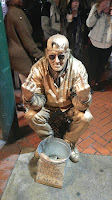Cafe Du Monde, for the originality of coffee, quality of powder-sugared treats, and affordability! The constant line at this cozy coffee shop did not scare anyone, as the wait was well worth the fresh dough coated in powdered sugar and served with ten napkins. This place in New Orleans spoke to its tradition, as chicory was added to coffee originally because coffee supplies were low and chicory had a similar taste. The locals grew to expect this taste in their coffee and Cafe Du Monde never feared to keep it. I preferred the Cafe Au Lait, as the coffee is doused in milk and the chicory is a faint aftertaste. I watched the staff line up with trays, a double order of beignets, two cafe au laits, as business never stopped neither did they. There was actually a lot of seating for patrons, considering the kitchen was crowded. I am still unsure how they kept up and served fresh beignets to every customer. Everyone who visits New Orleans should stop here and at least try the coffee, although some may hate it. Everyone should eat the beignets, as this French doughnut is not found as affordable or delicious anywhere else.
Frenchman Street, the easiest place to find free and worthwhile bands in America. As I stepped onto the street, each bar had a different band, playing their version of jazz and blues. No one was charging an entrance fee, which was hard to believe because I am from a much smaller city with lower quality musicians and less interesting bars that all require a fee to enter. The music played on Frenchman Street was that of passion, found deep within the soul. Barhopping had an entirely new meaning, as it now felt more like bandhopping. I was told that Frenchman Street is where the locals frequent. It is a part of New Orleans that is not rampant with only tourists. If you want to see the real music of New Orleans stop on Frenchman Street. Some of my favorites were BMC, Vaso, BB Kings, and Bamboulas. Frenchman Street also had a public art market several times a week. Gorgeous string light bulbs creating a roof of light above the galleries. I enjoyed admiring this art, although it was less affordable to my student wallet.
My favorite part of the trip was making close friends with my roommates Donielle and Sarah. It was a unique experience to visit a new city with people that I am not very close to. It builds relationships quickly and learning to explore a new place together created sort of a team. Of course the art and music were food to my soul and I could likely move to New Orleans with ease and make a living from my painting and poetry. My favorite part of the class was learning the abyss of history that New Orleans has on every corner. When I return, I could be the tour guide for the group, as I have heard most of the history in several versions between four tour guides and an instructor who frequents the city. I learned that the diverse inhabitants that embark New Orleans can not be so easily described. They have a unique way of refusal to conform, innovative in their art and music, and talented in making money from their personal gifts instead of a proper profession. I said if all else failed in job prospects of New Orleans, you could always become certified as a tour guide. I learned that I must travel the world a loner, as I am unique and nonconforming like those of New Orleans. I came on the trip knowing almost half of the travelers, but I also came to realize that they were not the type of friends I could rely on. I am different and it can be intimidating, but I must embrace my innovative ways of life and prosper on the soul that feeds my talents. I cannot worry about the gossip that is heard or the people who were supposed to care for me. I have to stand up for what I believe and be myself, regardless of the opinions of others. I have a sense of Bohemian artists, style somewhere found between the free-spirit of a hippy and the articulate tastes of a hipster. My knowledge was earned and my experiences throughout life have impacted my soul to understand darkness and seek to bring light to those who empathize. Those who view me as perfect have not yet met me; they lack the vision of my past and how it has created my enriched present. I will continue to dance to my own beat and to speak truths, regardless of those who spread rumors. I will be my own person, without shame or apology. I will attract those who feel similarly, who can respect a unique individual without being threatened by their own insecurities. New Orleans has reassured my exclusive breed has a home and place of acceptance. That my rare and particular interests are appreciated by many, and that my current state in life is one of learning that most opinions are not relevant to my accord.


















































